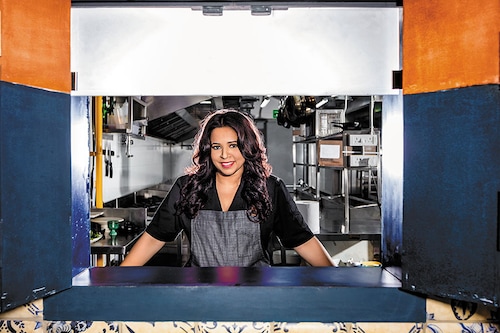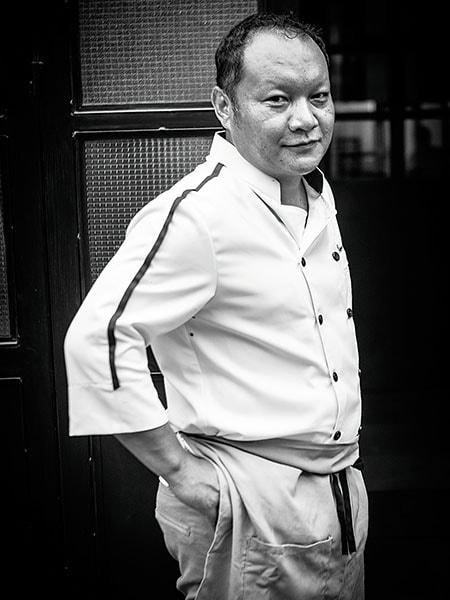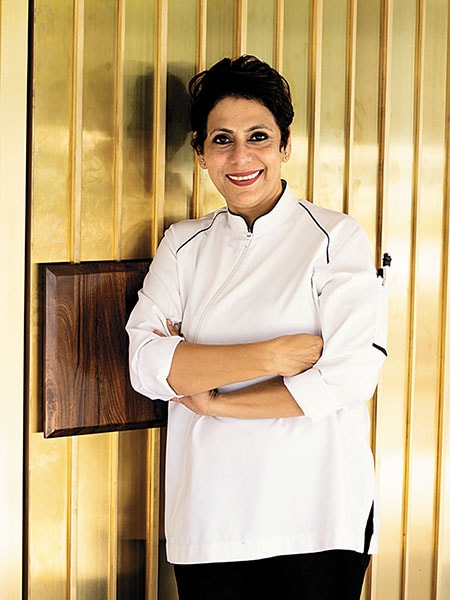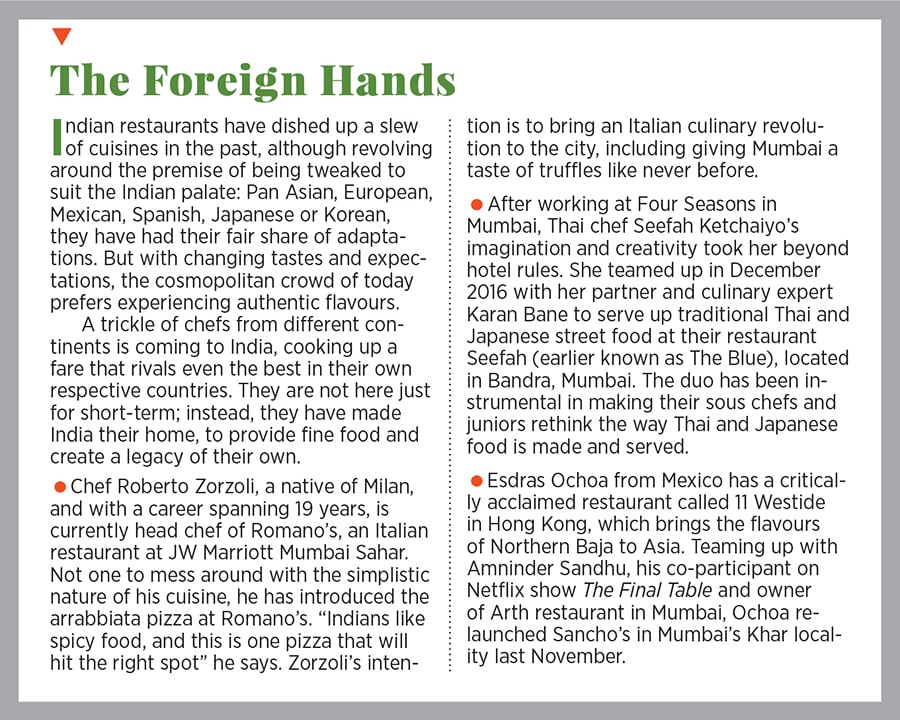Putting a face to the food
The new generation of chefs is becoming synonymous with its own restaurants, while blending global experience with food trends


 Pallavi Jayswal of Uno Más
Pallavi Jayswal of Uno Más
Image: Ayush DasIn 2012, Saransh Goila undertook a 20,000-km long, 100-day road trip across India to discover the country’s rich food heritage. His findings and experiences culminated in him launching Goila Butter Chicken, a takeaway brand, in Mumbai in 2013, followed by his take on butter chicken being featured in Masterchef Australia (where he was a guest judge) in 2018. An iconic dish that has defined Indian food worldwide, butter chicken also made Goila one of the many to put India on the global food map, all over again.
Goila is part of a new generation of restaurateurs and chefs, who, inspired by veterans such as Manish Mehrotra of Indian Accent and Ritu Dalmia of Diva, are becoming the face of their enterprises by going beyond the generic, and riding on global tastes and trends.
By observing the international food landscape, there are two trends that take shape: First is the concept of hyperlocal ingredients, with chefs sourcing ingredients locally—sometimes actually from their own backyards—and using traditional cooking methods to churn out popular regional delicacies in new formats. The second trend is of chefs cooking micro-regional cuisines from their neighbourhoods, or picking a world cuisine and serving it in its original form.
To achieve these ends, those in the business are realising the power of collaborations that enable a convergence of many minds to formulate dining concepts. One example of this is the coming together of Food Matter (Gauri Devidayal and Jay Yousuf’s hospitality group that runs Mumbai’s The Table and Magazine Street Kitchen) and Neighbourhood Hospitality (Abhishek Honawar, Pankil Shah and Sumit Gambhir’s enterprise that runs Woodside Inn, The Pantry, and Bombay Vintage). Sharing success in Mumbai’s food scene, the brains behind the two groups decided to get together— dubbing themselves The Colaba Cartel—to address SoBo’s thirst for stand-alone haunts. Bawmra Jap of Bomra’s
Bawmra Jap of Bomra’s
Image: Magazine ST Kitchen
While this collaboration was cooking, Bomra’s was born in the bylanes of Candolim in Goa. Chef Bawmra Jap, from northern Myanmar, had moved to India because of his wife’s research work, and decided to exercise his natural skillsets and Burmese roots to open the restaurant in 2004, which quickly gathered much critical acclaim. Last August, Jap became consultant chef at Miss T, a Southeast Asian restaurant in Mumbai, conceptualised by The Colaba Cartel. With Jap, the Cartel dealt a winning hand to nail a concept that appealed to the city’s dining sentiments.
While Bawmra popularised Burmese cuisine in India, Pallavi Jayswal, chef and co-founder of Uno Más, brought in Spanish flavours. “Nessun Dorma Food Ventures isn’t really a company that belongs to me. But actually an idea where I belong,” says Jayswal. “It’s much more than a company to me and, in a sense, an extension of myself.”
Hailing from the town of Raniganj in West Bengal, and with a career spanning public relations to design, Jayswal’s cooking instincts eventually took her to London’s Le Cordon Bleu in 2013. Although she could have looked at foreign shores for making her hospitality debut, she decided to return to India and have stints at restaurants such as Olive Bar & Kitchen, Indigo, and The Bombay Canteen. Last October, she unveiled Uno Más in Mumbai’s Bandra-Kurla Complex. Julia Carmen Desa of Tres
Julia Carmen Desa of Tres
Image: Jeevan Mehra
Another alumnus of London’s Le Cordon Bleu, Toshin Shetty was gifted an apron by his father when he had turned 10. Hailing from a family that pioneered the Udipi restaurant scene in Mumbai—with New Welcome in south Mumbai in 1941 (renamed Ankur Restaurant in 1979), Neo Welcome (1956) and Meghdoot (1971) in Ghatkopar, Ivy Restaurant & Banquets (2001) in Chembur—Shetty chose the road less traveled and took up confectionary making.
Shetty studied at the Gelato University in Carpigiani, and attended numerous chocolate workshops in Paris, before eventually returning to India. “I always planned to come back to India as I saw a huge unfilled market space that I wanted to capture. Moreover, I am the third generation of my family that is part of the hospitality industry in India,” says Shetty, who established his eponymous patisserie in Mumbai in October 2015. He brings European flavours to the Indian palate and matches global trends with his macarons, cookies, handcrafted pralines and chocolates..jpg) Patissier Toshin Shetty
Patissier Toshin Shetty
Image: Toshin Patisserie
Apart from their work with cuisines and cultures, another common thread that binds many of these Indian chefs together is the fact that they have returned to their nests after honing their talent abroad and finding a niche to fill. This homecoming has been taking place not only among those who have just trained abroad, but also among those who have established themselves on foreign shores.
Himanshu Saini had won Delhi’s heart with his unique melange of ingredients and cooking techniques, while he worked at Manish Mehrotra’s globally appealing restaurant Indian Accent. Therefore, it was simply a matter of time before hospitality mogul Bhupender Nath and Saini got together to launch Trèsind, and Carnival by Trèsind, in Dubai in 2014.
Considered one of the youngest tastemakers in Indian cuisine, 31-year-old Saini found his way back to India, with Nath opening a branch of Trèsind in Mumbai last December. “When we decided to expand our global footprint, being a company founded by an Indian, our unanimous first choice was India, and more so Mumbai. Keeping in mind the plan to open one Trèsind per country, it was essential for it to be present in the heart of the country, which Mumbai is,” says Nath..jpg) Esdras Ochoa, chef at Sancho’s in Khar, Mumbai
Esdras Ochoa, chef at Sancho’s in Khar, Mumbai
Image: Assad Dadan
Another Delhi-based chef, Julia Carmen Desa, who specialises in global contemporary cuisine (she ran Holland Village in Singapore, Pearl at Hilton Hotel in Abu Dhabi, and L’aurberge in England) is now the co-partner of Tres, a contemporary European cuisine restaurant, in the upmarket Lodhi Colony of Delhi. “After spending time mentoring boys and girls on different shores, I decided to channel my learnings to my country’s very own. It was time to bring out the best in talent from my homeland and teach them all that I could,” says Desa, who is mentoring her staff of around 38 recruits at Tres.
Desa decided to return to India after the country’s vibrant agricultural produce appealed to her inner need to experiment further. “Our produce maybe limited, but I have learnt the art of deciphering taste profiles and reimagining international flavours and adapting them to our palate,” she explains. “When I cook chorizo, I use my Goan roots to decipher and understand the flavour. Tres’ presentation of chorizo has been inspired from one of my travels to Barcelona, where a local tapas bar was serving it.”
In returning to India to uplift their home turf’s food-scape, these chefs are using their learnings, resources and global experiences to develop unique, standout concepts, thus helping build a vibrant and flourishing industry that can attract future generations of protégés.
First Published: May 04, 2019, 06:28
Subscribe Now